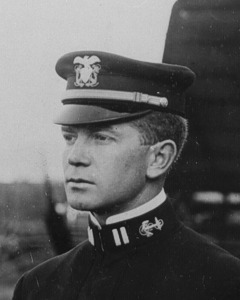
Lieutenant Theodore Gordon Ellyson, USN, Naval Pilot No. 1, in 1911.
From December 1908 until February 1910, when the US Navy’s submarine force consisted of nine submarines in active commission and three in reserve, he was attached to submarines in the orient. Returning to the United States, he then commanded the First Submarine Division and served in other related duties.
On 2 January 1911, he reported for aviation instruction at Los Angeles. During the following 28 months, he was closely associated with the development of naval aviation, then in its infancy. In 1915, his excellent work in every phase of sea-going flying earned him the distinction of being appointed Naval Pilot Number One. In January 1918, while serving as gunnery officer in South Carolina, he was also issued Naval Aviator’s Certificate Number One.
In June 1918, he reported for duty with a submarine chaser squadron at the US Naval Base, Plymouth, England, and he continued in this duty throughout the rest of World War I. For distinguished service in the development of successful sub-chaser tactics and doctrine he was awarded the Navy Cross.
After the war, he reported for duty with Nucleus Crew Number 19 at Spithead, England, for the purpose of aiding in taking over German transports. He took command of USS Zeppelin (née SS Zeppelin) and made one trip from France to the United States with returning troops of the AAF. He then helped outfit and commission destroyer J. Fred Talbott (DD 156) and served in her in the Atlantic before commanding Little (DD 79) and Brooks (DD 232).
From January 1921 to December 1922, he served as a naval aviator at the Naval Air Station, Hampton Roads, Virginia and in the Bureau of Aeronautics. Following two and one half years with the United States Naval Mission to Brazil, he returned to the Bureau of Aeronautics, then served as executive officer of both Wright (AV 1) and Lexington (CV 2), the latter after fitting her out and placing her in commission.
On 27 February 1928, his 43rd birthday, Commander Ellyson’s brilliant well-rounded career was terminated when the plane in which he was making an emergency night flight from Hampton Roads to Annapolis, Maryland crashed for unknown reasons in Chesapeake Bay. He was buried at the Naval Academy Cemetery in Annapolis.
In 1961, at a ball celebrating the fiftieth anniversary of naval aviation, his widow Mrs. T. G. Ellyson, received the Gray Eagle Award, honoring honor him as the senior active naval aviator 1911–28. In 1964, he was enshrined in the National Aviation Hall of Fame at Dayton, Ohio.
Source: A History of the USS Ellyson (Elly Mae), DD 454, DMS 19, prepared for the Ellyson Reunion, October 11–13, 1985, Charleston, South Carolina.